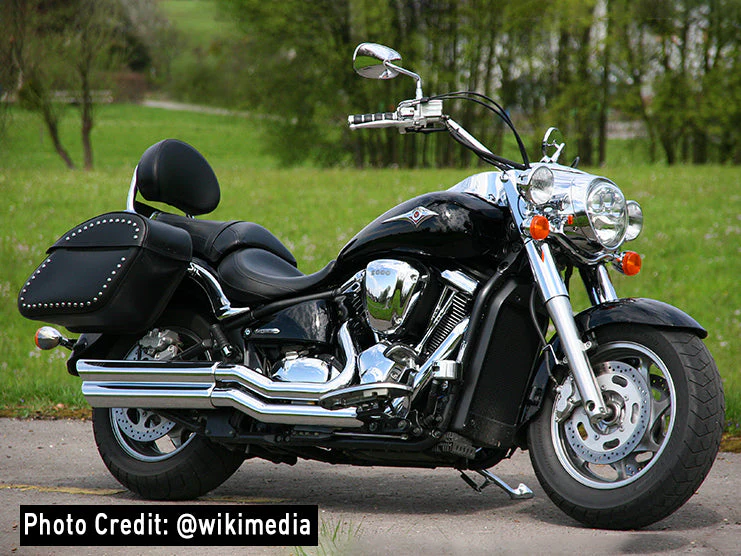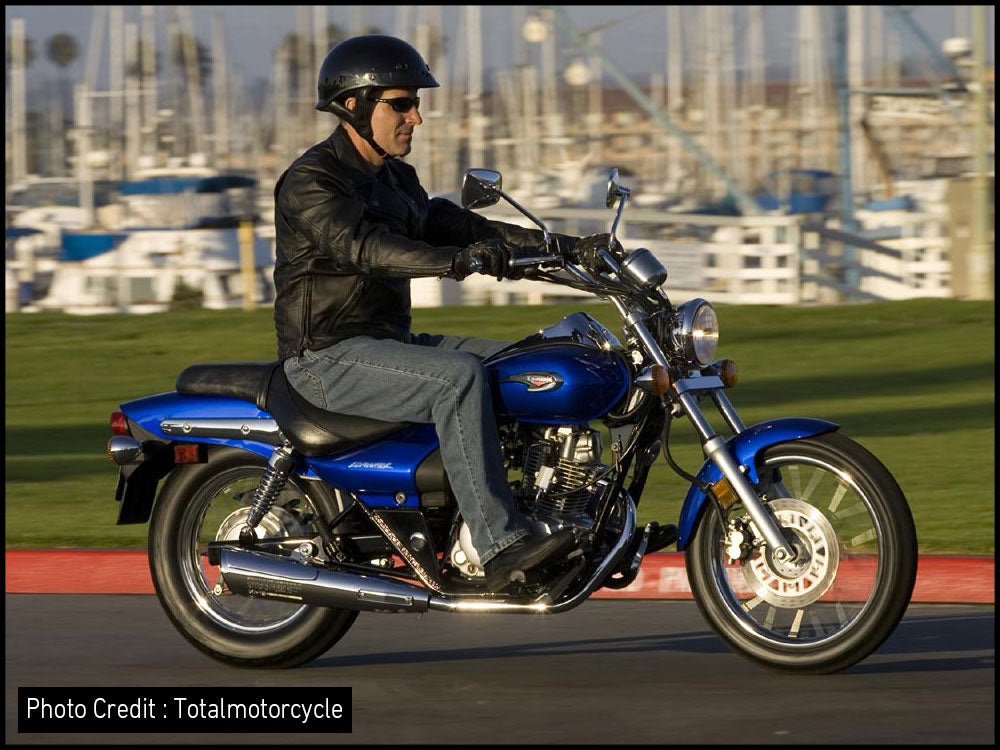Table of Content
Looking for a large displacement bike to take your cruising experience to the next level? Want to feel enormous engine power on the highways? If so, then the Kawasaki Vulcan 2000 is right up your alley!
The Vulcan 2000 by Kawasaki is a great combination of the style and power of the Kawasaki Vulcan line, with the big presence and a 2053cc displacement of V-twin muscle bikes.
The bike is a big giant motor on wheels that is fun to ride, has great ergonomics, and can produce an enormous amount of torque.
Come and explore the history, detailed specs, and performance of this Kawasaki muscle cruiser in this read.
1. A BRIEF HISTORY OF KAWASAKI VULCAN 2000 VN2000
The Kawasaki Vulcan 2000 debuted in the year 2004 as the largest member of the Kawasaki Vulcan series.
The Vulcan (VN) Series
Kawasaki has been using the Vulcan name for their custom cruiser motorcycles, with the model designation of VN. All the models were powered with a traditional V-twin engine ranging from 120 to 2053cc.
Kawasaki Vulcan 2000 Series:
The Vulcan 2000 series was produced from 2004 to 2010. Kawasaki’s objectives with the VN2000 were to create the world’s largest displacement V-twin cruiser with the best horsepower and torque.
Based on the same frame, Kawasaki introduced three different variations of the Vulcan 2000 base model: the Vulcan 2000 Standard, Classic, and Classic LT. All three models had the same liquid-cooled 2053cc V-twin engine that produced a torque of 141 ft/lbs at 28,000 rpm.
However, the three models also featured some minor differences between them. The most noticeable is the “bug-eye” chrome nacelle projection headlight, which debuted with the Vulcan VN2000A basic model. Until the 2006 launch of the Vulcan Classic VN2000D, which used a more traditional headlight, this was Kawasaki’s lone offering. The Vulcan Classic LT VN2000F was also launched in 2006. The Classic LT had a similar design to the Classic, but it came with saddlebags, a windshield, passenger floorboards, and a passenger backrest.
Kawasaki Vulcan 2000 VN2000
With the 2004 Vulcan 2000, Kawasaki established a new benchmark in terms of engine displacement, power, and cruiser feel. Kawasaki completed its Vulcan line of cruisers with the VN2000, and virtually dominated the competition, including Harley-Davidson.
1.1 KAWASAKI VULCAN 2000 (2004-2005)
The 2004 Vulcan 2000 was characterized by its 2053cc engine, which was the first to go past the 2000cc limit and opened new boundaries for this vehicle class. The 2005 model followed the same features and design.
- Color Options: Black, Blue, Green
1.2 KAWASAKI VULCAN 2000 (2006-2007)
Kawasaki updated the style queues of the 2006 Vulcan 2000 with a chrome instrument panel with its large face speedometer and a powerful four-bulb, projector-type headlight encased in signature chrome Nacelle headlight. There were no significant updates for the 2007 model except for the color.
- Color Options:
2006: Ebony/Galaxy Silver, Metallic Ocean Blue/Metallic Phantom Silver
2007: Ebony/Pearl Meteor Gray
1.3 KAWASAKI VULCAN 2000 (2008-2010)
The 2008 Kawasaki Vulcan 2000 featured a rear suspension update with a triangulated steel tube swingarm with direct-action single shock, eight-way rebound damping / 3.9 in, fully-adjustable spring preload. Kawasaki also introduced a new color option for the 2008 model.
The Vulcan 2000 did not change much between 2009 and 2010. However, Kawasaki did add some new design features and color options.
- Color Options:
2008: Metallic Diablo Black
2009/2019: Metallic Titanium
2. KAWASAKI VULCAN 2000 VN2000 AT FIRST GLANCE
Largest Cruiser Ever:
Kawasaki produced their largest V-twin motor, fine-tuned it to offer the best power and torque, and then gave the Vulcan 2000 a classic design to deliver an unmatched look.
Without a doubt, the Kawaski Vulcan 2000 is one of the best and largest cruisers ever constructed in history.
Powerful Performance:
Every bike manufacturer has a big bad beast in its line, Honda has the VTX1800, Yamaha has the Raider, and Suzuki has the M109. But none of them come close to the Kawasaki Vulcan 2000 when it comes to powerful performance.
Biggest V-twin Engine:
The Kawasaki Vulcan 2000 boasts the highest capacity V-twin engine ever put into production by a major manufacturer. With a displacement of 2053cc, this makes the Kawasaki Vulcan 2000’s engine one of a kind. The Vulcan 2000 outpowers most tiny automobiles with 141 Nm of torque at 2800 rpm and 112 hp at 4800 rpm. It’s also been deliberately built to provide that engine power in a seamless manner.
High Speed:
The bike is a great highway cruiser and capable of cruising at 70 mph at 2500 rpm. The Vulcan 2000 has remarkable control when it pulls away from a stop for the first time. Even tame. Until you have enough space to allow the bike to run at a higher speed .
Ergonomics and Seat:
The ergonomics, chassis, and handling of the Vulcan 2000 package are all excellent. The seat is solid but comfy despite its extremely low position. It’s cleverly constructed and offers a pleasant cushion for a bottom on a 150-mile day trip. The bars and floorboards stretch out a little, as they should on a bike this long and low, but once you get used to being on the saddle of the Vulcan 2000, the distance hardly seems like a hindrance .
Cylinder and Crankshaft:
To get around the bike’s sheer mass, Kawasaki used pushrods to activate the four valves per cylinder, lowering the engine’s height and the bike’s center of gravity. Overhead cams would have made a huge engine with a stroke larger than 123.2mm impossible to install.
The single-pin crankshaft on the Vulcan 2000 helps it to produce the classic V-twin sound, while the dual counter balancers and rubber engine mounts keep those massive explosions in each cylinder head from causing violent vibrations under the rider.
Transmission:
Given the huge bursts of power generated by this larger-than-life engine, a five-speed transmission delivers power to the rear wheels via a belt drive system, ensuring the on/off throttle transitions are seamless.
Amazing Style:
The amazing style makes it difficult not to fall in love with this bike, which combines smooth lines and an outstanding fit and finish, resulting in a motorcycle with a lot of attention to detail.
With the Vulcan symbol on each side, the lines of the headlight continue to the huge fuel tank (5.50 gallons). What’s fantastic about this unit is that it has an instrument panel, so the rider’s eyes can still see and read the speedometer.
This bad boy was covered with chrome plating across its chassis, with a black paint job covering the chrome on the back fender. The transmission side covers, mirrors, and exhaust are also covered in chrome to complete the aesthetic look.
3. KAWASAKI VULCAN 2000 VN2000: A BUYER’S GUIDE
3.1 How much does the Kawasaki Vulcan 2000 weigh?
The Vulcan 2000 is a heavy bike with a dry weight of 332 kg (732 lbs) and a curb weight of 380 kg (837 lbs).
3.2 How fast is the Kawasaki Vulcan 2000?
The Kawasaki Vulcan 2000 has a top speed of around 120-150 mph. The bike’s quarter-mile time of 12.43 sec at 104.2 mph puts it just ahead of Honda’s VTX1800, Yamaha’s V4 V-Max, and Harley’s V-Rod.
3.3 How long does the Kawasaki Vulcan last?
It depends on how well the owner treats his/her Vulcan 2000 . The Kawasaki Vulcan may endure well over 75,000 miles if the owner stores and rides it properly, maintaining the vehicle according to the manual, including frequent suspension and lubrication of components. On average, a Vulcan can last over 15 years if driven 5,000 miles each year.
4. KAWASAKI VULCAN 2000 VN2000 DETAILED SPECIFICATIONS
4.1 GENERAL INFORMATION
| Manufacturer | Kawasaki |
| Production | 2006-2010 |
| Model | Kawasaki Vulcan 2000 (VN2000) |
| Year | 2010 |
| Category | Custom Cruiser |
| Color | Metallic Titanium |
| Price | $15,999 |
4.2 DIMENSIONS AND CAPACITIES
| Wheelbase | 1735mm (68.3 in) |
| Overall Length | 2353mm (99.8 in) |
| Overall Width | 1026mm (40.4 in) |
| Overall Height | 1156 mm (45.5in) |
| Seat Height | 681mm (26.8 in) If adjustable, lowest seating |
| Ground Clearance | 135mm (5.3 in) |
| Trail Size | 183mm (7.2 in) |
| Curb Weight | 380.1 kg (837.9 lbs ) |
| Fuel Capacity | 5.50 US gallons (20.81liters) |
4.3 ENGINE AND TRANSMISSION
| Engine Type | V2, Four stroke |
| Cooling | Liquid Cooled |
| Displacement | 2053ccm (125.27 cu in) |
| Bore and Stroke | 4.1 in x 4.9 in (103.0 mm x 123.2 mm) |
| Compression Ratio | 9.5:1 |
| Valve Train | DOHC |
| Ignition | TCBI with Digital Advance |
| Starting | Electric |
| Fuel System | Injection, Digital fuel injection, dual 46mm Keihin throttle bodies |
| Transmission | Five-Speed |
| Final Drive | Belt |
4.4 PERFORMANCE
| Maximum Power | 102.99 HP (76.8 kW) at 4800 rpm |
| Maximum Torque | 191.19 Nm (141 ft/lb) at 2800 rpm |
| Top Speed | 124 mph |
| Fuel Economy/Consumption | 18.1 km/liter |
4.5 CHASSIS, SUSPENSION, BRAKES AND WHEELS
| Frame Type | Steel double cradle with box section single tube backbone |
| Rake | 32.0 ° |
| Front Suspension | 49mm telescopic fork / 5.9 in |
| Rear Suspension | Triangulated steel tube swingarm with direct action single shock, fully-adjustable spring preload, eight-way rebound damping / 3.9 in |
| Front Brake | Double Discs |
| Rear Brake | Single Disc |
| Front Tire | 150/80 – 16 |
| Rear Tire | 200/60 – 16 |
5. AFTERMARKET LUGGAGE & MODIFICATION OPTIONS FOR KAWASAKI VULCAN 2000 VN2000
Despite the fact that the Kawasaki Vulcan 2000 is an older model, this beast can still be given a modern design with some high-quality aftermarket parts. Kawasaki has a variety of cruiser parts that you may use to give your Vulcan 2000 a new look. Crash bars, fairings, headlights, and seats are just a few examples.
This fantastic cruiser can also be customized to make your road trip even more enjoyable and convenient. Saddlebags and luggage racks can be used to carry your luggage. You may also add passenger backrests and sissy bars to make the bike even more comfortable and safe for extended rides.












Leave a comment
All comments are moderated before being published.
This site is protected by hCaptcha and the hCaptcha Privacy Policy and Terms of Service apply.